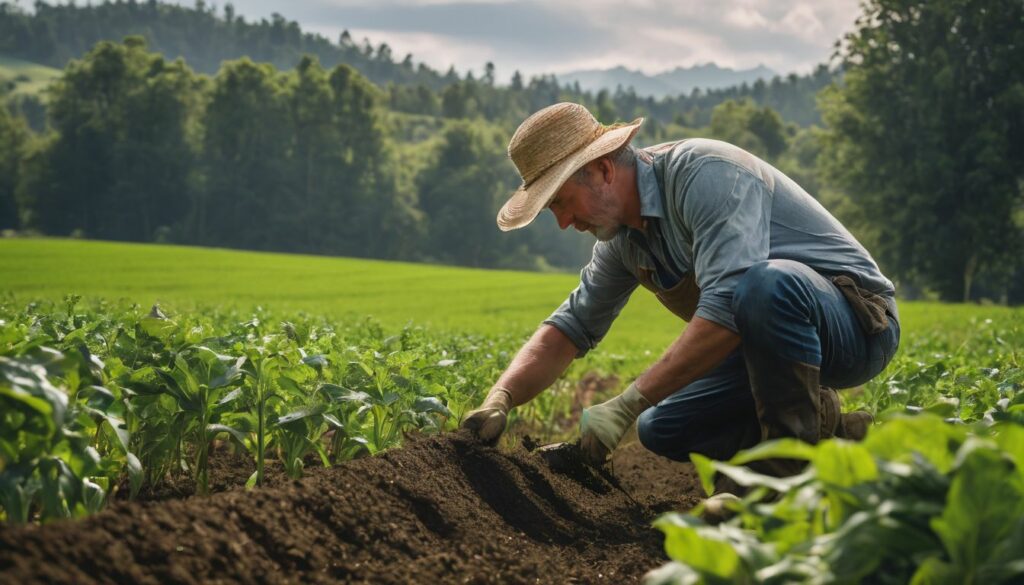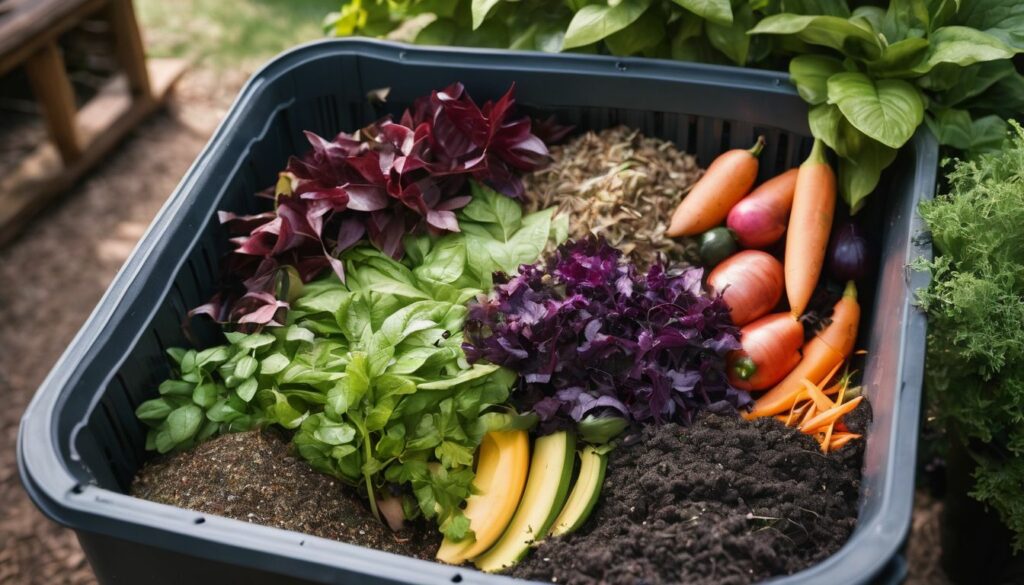Are you looking to get more from your land while caring for the environment? Many farmers and landowners face the challenge of balancing productivity with sustainable practices. Agroforestry might just be the game-changer you’re searching for! It’s an ancient method that has shaken hands with modern approaches to make your acres work wonders—both for your pocket and the planet.
Here’s a fact: agroforestry blends agriculture with tree-growing, turning farms into thriving ecosystems. This guide will dig into how planting trees among crops can boost your farm’s health and yield, protect nature, and even help fight climate change.
With smart strategies and real-world solutions, we’ll show how agroforestry can rejuvenate your land. Ready to grow into a greener future? Keep reading—there’s plenty of ground to cover!
Key Takeaways
- Agroforestry blends agriculture with tree – growing, providing diversified production systems that create a more resilient and sustainable agricultural operation.
- Integrating trees into farming systems through agroforestry improves soil fertility, reduces the need for chemical inputs, and contributes to carbon sequestration, promoting environmental conservation and sustainability.
- Agroforestry supports biodiversity conservation by creating diverse habitats for various plant and animal species within agricultural landscapes while enhancing the resilience of farming systems in adapting to climate change.
- By adopting agroforestry practices, farmers can increase profitability by diversifying income streams, reduce human impacts on the environment through sustainable land use, and mitigate negative effects of climate change.
What is Agroforestry?
Agroforestry is the practice of integrating trees and woody perennials into agricultural landscapes, dating back to ancient times and has various applications in modern land management.
Definition
Agroforestry is a way of using land where trees and shrubs grow together with crops and animals. It blends farming with tree planting to create a system that helps nature and people.
This method includes both old ways of growing food and new ideas, making the most out of every piece of land.
Trees on farms work well because they can give us fruits, nuts, wood, and more—all while protecting the earth. By having both plants and livestock in one place, farmers can get more from their land without hurting it.
Next up: let’s dig into agroforestry’s past and how people have used it through time.
History
Agroforestry has been practiced for centuries, dating back to ancient civilizations such as the Mayans and Aztecs. These communities integrated trees with their crop production, recognizing the symbiotic relationship between different plant species.
Historically, agroforestry provided food, fuel, and other essential resources while maintaining ecological balance and sustainability. Over time, this land management approach has evolved across diverse cultures and geographical regions, contributing to the rich tapestry of agroforestry practices we see today.
In more recent history, agroforestry gained attention in response to global challenges such as deforestation and environmental degradation. Efforts to promote sustainable land use led to a resurgence of interest in incorporating trees within agricultural landscapes.
Applications
Agroforestry is used in different ways:
- Diversified production systems: It combines trees and shrubs with crop and livestock farming, increasing the variety of products that can be grown or harvested on the same piece of land.
- Increased profitability: By incorporating trees and shrubs, agroforestry can contribute to total farm income and provide additional products for sale, enhancing overall profitability.
- Reduced human impacts on the environment: Agroforestry supports environmental sustainability by conserving soil, water, and biodiversity through integrated land management.
- Adaptation to climate change: The intentional mixing of trees into agricultural systems helps reduce the negative impacts of climate change by improving ecosystem resilience and mitigating greenhouse gas emissions.
The Scientific Basis of Agroforestry
Agroforestry plays a key role in sustainable agriculture by promoting biodiversity, improving soil and plant growth, and achieving other environmental goals.
Role in sustainable agriculture
Agroforestry plays a vital role in sustainable agriculture by enhancing soil fertility, reducing the need for chemical inputs, and improving overall ecosystem health. By integrating trees into farming systems, agroforestry helps to prevent soil erosion and retain moisture, contributing to sustainable land use and increased agricultural productivity.
Additionally, it provides shade for crops and livestock, fostering a more resilient farming system that can adapt to changing environmental conditions. Furthermore, agroforestry contributes to carbon sequestration and mitigates the effects of greenhouse gas emissions, aligning with the goals of sustainable agriculture and environmental conservation.
In addition to these benefits, agroforestry promotes biodiversity conservation by creating habitats for various plant and animal species within agricultural landscapes. The diverse range of plants in agroforestry systems supports pollinators and natural pest control mechanisms while providing additional sources of food and income for farmers.
Biodiversity benefits
Biodiversity thrives in agroforestry systems, as the integration of trees and crops creates diverse habitats for various flora and fauna. The presence of multiple plant species supports a wide range of insects, birds, and mammals, contributing to a balanced ecosystem.
This diversity promotes natural pest control while also enhancing soil health through the decomposition of organic matter by a variety of microorganisms. Furthermore, agroforestry contributes to genetic diversity by preserving native tree species and promoting the cultivation of indigenous plants alongside traditional crops.
The combination of different vegetation types within agroforestry systems acts as a refuge for numerous species, ultimately enriching the overall biodiversity.
Soil and plant growth
Agroforestry positively impacts soil and plant growth. The presence of trees in farming systems increases soil fertility by enhancing organic matter content and nutrient availability.
Agroforestry also promotes diverse microbial communities, improving overall soil health. By providing shade and wind protection, trees help create a favorable microclimate for crops, ultimately leading to increased productivity and enhanced plant growth.
Furthermore, the deep roots of trees can access water and nutrients from deeper soil layers than most agricultural crops can reach, reducing competition among plants for resources.
This can be especially beneficial during dry periods when surface soils become depleted. Overall, the integration of trees into agricultural systems plays a vital role in maintaining healthy soils while supporting robust plant growth.
Other environmental goals
Agroforestry serves other environmental goals besides providing diversified production systems and increasing profitability. By integrating trees with agricultural practices, agroforestry helps in soil conservation, water conservation, and biodiversity conservation.
It also contributes to carbon sequestration, reducing the effects of greenhouse gas emissions. Moreover, agroforestry reduces the need for chemical inputs in farming and enhances overall ecosystem health by improving soil fertility and resilience of farming systems.
This approach not only benefits farmers but also promotes sustainable land use while mitigating the negative impacts of climate change.
Benefits of Agroforestry
– Diversified production systems create a more resilient and sustainable agricultural operation.
Diversified production systems
Diverse production systems in agroforestry combine various types of crops, trees, and livestock on the same land. This diversity helps farmers spread risks and increase productivity.
For example, by growing different crops alongside trees, farmers can earn from multiple sources and gain more stable incomes. Additionally, integrating livestock with tree agriculture can provide benefits like natural fertilization and pest control.
These diversified systems also contribute to enhanced ecological sustainability and soil health while offering a wide range of products for consumption or sale.
Furthermore, diverse agroforestry systems support biodiversity conservation by creating habitats for numerous plant and animal species. By integrating different elements into farming practices, agroforestry ensures a sustainable approach that is beneficial for both humans and the environment alike.
Increased profitability
Agroforestry can lead to increased profitability for farmers by providing multiple income streams. The combination of tree crops with traditional agriculture diversifies production systems, contributing to higher total farm incomes.
Additionally, agroforestry allows for the sale of additional products derived from trees and shrubs, enhancing overall financial returns and supporting sustainable land use management.
Furthermore, this approach also helps in reducing the need for chemical inputs, which can lower farming costs while increasing productivity and resilience.
Incorporating agroforestry into farming practices not only provides economic benefits but also contributes to soil conservation, water conservation, biodiversity conservation, and climate change mitigation.
Reduced human impacts on the environment
Agroforestry reduces human impacts on the environment by promoting sustainable land use and decreasing reliance on chemical inputs. The integration of trees and agricultural production helps to conserve soil and water, mitigating erosion and improving overall ecosystem health.
Agroforestry also contributes to carbon sequestration, which can help offset greenhouse gas emissions. By diversifying production systems, agroforestry minimizes environmental degradation often associated with conventional farming practices.
This approach enhances the resilience of farming systems, reducing pressure on natural resources and contributing to a healthier environment for future generations.
By incorporating agroforestry into land management practices, farmers can reduce their dependence on chemical inputs while safeguarding natural resources such as soil and water. This approach not only lessens the negative impact of agriculture but also improves overall ecosystem health by preserving biodiversity and fostering carbon sequestration.
Adaptation to climate change
Agroforestry plays a crucial role in helping farmers adapt to climate change. By integrating trees into agricultural systems, agroforestry helps provide shade and windbreaks which can protect crops from extreme weather events such as storms and heatwaves.
The presence of trees also helps regulate temperatures, maintain soil moisture, and reduce water runoff, all of which are essential for adapting to the changing climate. Furthermore, agroforestry contributes to carbon sequestration through the trees’ ability to absorb carbon dioxide, thereby mitigating the effects of greenhouse gas emissions.
This practice not only enhances the resilience of farming systems but also fosters overall ecosystem health by contributing positively to adaptation strategies for climate change.
Challenges and Potential Solutions
Historical use of agroforestry has faced challenges in terms of land tenure and ownership. Potential solutions include collaborative land management agreements and policy support for agroforestry practices.
To learn more about these challenges and potential solutions, keep reading our comprehensive guide on the benefits of agroforestry!
Historical use
Agroforestry has been practiced for centuries by indigenous communities around the world, integrating trees into their farming and land management techniques. The ancient Mayans, for example, used agroforestry methods to cultivate food crops alongside trees that provided shade and shelter.
Similarly, in Africa and Asia, traditional agricultural systems incorporated trees with crops and livestock to maximize productivity while maintaining ecological balance. These historical practices demonstrate the long-standing success of agroforestry in sustaining diverse ecosystems while providing essential resources for human livelihoods.
Today, modern agroforestry builds upon these historical foundations by incorporating scientific knowledge and innovative techniques to enhance sustainability and productivity. By learning from traditional wisdom and combining it with contemporary research, agroforestry continues to offer promising solutions for addressing current agricultural challenges while promoting environmental health and economic stability.
Challenges to implementation
After understanding the historical significance of agroforestry, it’s important to recognize the challenges that may arise during its implementation. These challenges include:
- Land Tenure Issues: Limited land access and ownership complexities can hinder the establishment of agroforestry systems.
- Knowledge and Awareness Gaps: Lack of awareness about the benefits and techniques of agroforestry among farmers can pose a significant challenge.
- Financial Barriers: Initial investment costs for establishing agroforestry systems may be prohibitive for some farmers.
- Policy and Regulatory Hurdles: Inadequate policy support and conflicting regulations can obstruct the widespread adoption of agroforestry practices.
- Market Access: Limited market opportunities for agroforestry products may deter farmers from investing in these diversified systems.
- Technical Support: Insufficient access to technical knowledge, training, and extension services can impede successful implementation.
- Social Acceptance: Cultural resistance or social norms may impact the acceptance and integration of agroforestry into traditional farming practices.
- Risk Perception: Uncertainty about potential risks associated with transitioning to agroforestry systems can create reluctance among farmers.
- Scalability Challenges: Integrating agroforestry at a larger scale while maintaining productivity requires careful planning and management.
- Long-term Commitment: Sustaining agroforestry practices necessitates long-term commitment and consistent efforts from farmers, which might be challenging under certain circumstances.
Possible solutions
To address the challenges of implementing agroforestry, potential solutions include:
- Increased awareness and education for farmers on the benefits and techniques of agroforestry, emphasizing its positive impact on farm profitability and environmental sustainability.
- Policy support through incentives and subsidies to encourage the adoption of agroforestry practices, promoting sustainable land use systems and diversification of production.
- Collaboration between research institutions, agricultural extension services, and industry stakeholders to develop and disseminate best practices for integrating trees into farming systems.
- Access to affordable tree seedlings and technical support for farmers to establish agroforestry systems, ensuring successful implementation and long-term viability.
- Integration of agroforestry principles into agricultural training programs, empowering the next generation of farmers with the knowledge and skills to incorporate trees into their farming practices.
- Formation of farmer cooperatives or networks to share experiences, resources, and expertise in implementing agroforestry, fostering a supportive community for sustainable land management.
- Advocacy for inclusive policies that recognize the value of agroforestry in mitigating climate change, conserving biodiversity, and improving overall ecosystem health.
- Engagement with financial institutions to provide tailored financing options for agroforestry projects, facilitating investment in regenerative agriculture practices that benefit both farmers and the environment.
Conclusion
In conclusion, agroforestry offers a sustainable approach to land management by combining trees and shrubs with crop and livestock farming. This practice delivers multiple benefits for the environment, climate, and farming, supporting nutrition, production stability, and farmers’ incomes.
The intentional mixing of trees into production systems creates environmental, economic, and social benefits while also contributing to carbon sequestration. By adopting agroforestry practices, farmers can improve soil fertility, reduce negative impacts of climate change, and enhance the resilience of farming systems.
Embracing agroforestry not only provides practical solutions but also holds the potential to make significant positive impacts on agriculture and our environment.
FAQs
1. What are the benefits of having trees on farms?
Trees on farms, as part of agroforestry, offer shade for crops and livestock, improve soil health and help make farming more sustainable.
2. How does agroforestry help in managing land better?
Agroforestry is a mix of crop management and tree planting which creates diverse land use systems. It’s good for the earth because it keeps the land healthy through intensive management.
3. Can agroforestry work with animals too?
Yes, regenerative agroforestry includes both plants and animals. Livestock management in these systems can help soils get better over time.
4. What is permaculture and how does it relate to agroforestry?
Permaculture is a way of growing things that works with nature instead of against it – like ecosystem services do in agroecology and sustainable agriculture systems.





